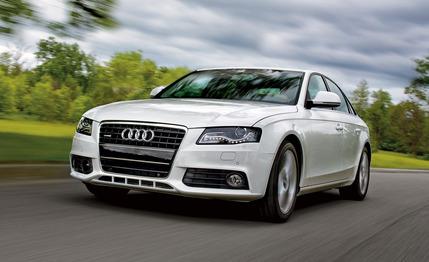 Road Test
Road Test
It’s fair to say that the folks at Audi have found their styling muse. After we swooned over the shape of the new S5 coupe, Audi basically added two doors to the design and called it the A4. It’s less zoomy-looking than the coupe, but it’s still sexy—unmistakably Audi—and won’t be confused with any other Auto Union offerings. But unlike BMW’s wild leap off the styling reservation, the A4 doesn’t jump out visually as a significant departure from Audi’s evolutionary progression that started with the first A4. Way back in 1996, we liked that first A4 well enough to have awarded it 10Best Cars honors three years running.
Now in its third generation wearing the A4 moniker, the new version rides on the B8 platform that underpins the A5/S5 and the forthcoming Q5 sport-ute. Instead of switching to a rear-wheel-drive layout such as that which underpins most of its competitors, Audi sticks with front- or all-wheel drive in the A4, the former coming as an entry-level version next spring. In order to combat the inherent handling handicap that is inescapable in this front-heavy drivetrain layout, the A4’s wheelbase has been stretched six and a half inches, to 110.6. That, combined with a reduced front overhang, means the weight distribution moves astern—55.5 percent of the new A4’s 3860 pounds are over the front wheels, which is about three percentage points less than the case of the last V-6 Quattro A4 we tested. To further improve the A4’s dynamic prowess, the all-wheel-drive system favors the rear wheels with a 40/60 front-to-back torque split.
How’s that for progress? What’s more, curb weight is up by just 40 pounds despite increases in overall length and width of 4.6 and 2.1 inches, respectively.
There are improvements in the interior as well, which has been an Audi strong point since that first A4. The layout is essentially the same as in the A5/S5, which is to say that even though the A4 is new, cynical automotive writers accustomed to a smorgasbord of driving options will view the interior as all too familiar. The MMI interface, which controls the radio, navigation, and sundry other configuration options, has the same buttons as in the A6 and A8, but here they’re somewhat more contoured, making the fingertip connection easier without the need to glance down at the controls. The A4 also has an optional blind-spot warning system, which unleashes a cluster of flashing LEDs on each of the side-mirror housings to get the driver’s attention. There’s also radar-based adaptive cruise control that is adjustable for the level of aggressiveness with which it uses the gas and brakes. The headlights, which feature an eyebrow-like line of LEDs for the daytime running lamps, tilt the beams higher at speeds above 75 mph for better highway visibility.
Nothing stands out about the feel of the front seats, but they turn out to be all-day comfortable and supportive in all the right places. Rear-seat legroom has grown almost an inch, and at 35.2 inches, it is more spacious than you’ll find in the BMW 3-series or Mercedes C-class. Combined with an increase in rear headroom of 0.3 inch, the back seat is far more comfortable than was the previous A4’s. The rear seats also split and fold to open up a pass-through to the trunk.
Under the hood, the direct-injection 3.2-liter V-6 adds variable lift to the intake valves, which is good for 10 additional horsepower, or 265 in all, although torque is unchanged at 243 pound-feet. Audi claims a fuel-economy increase of 10 percent in both city and highway EPA numbers. The 2.0-liter turbo also gets variable lift, except on the exhaust side, and there’s a modest bump of 11 horsepower, to 211, but there’s a huge torque increase of 51 pound-feet, to 258. Initially, both versions will be offloaded with all-wheel drive and six-speed automatics; by next spring, the 2.0T will be offered with a six-speed manual, and the front-wheel-drive 2.0T will come with a continuously variable automatic transmission.
The V-6 hustled our A4 3.2 Quattro test car from 0 to 60 mph in 5.7 seconds, which is an impressive number but absolutely astonishing compared with the 7.5-second time of the last-gen V-6 A4 we tested in October 2005. The previous quarter-mile time of 15.7 seconds at 100 mph improves by 1.4 seconds.